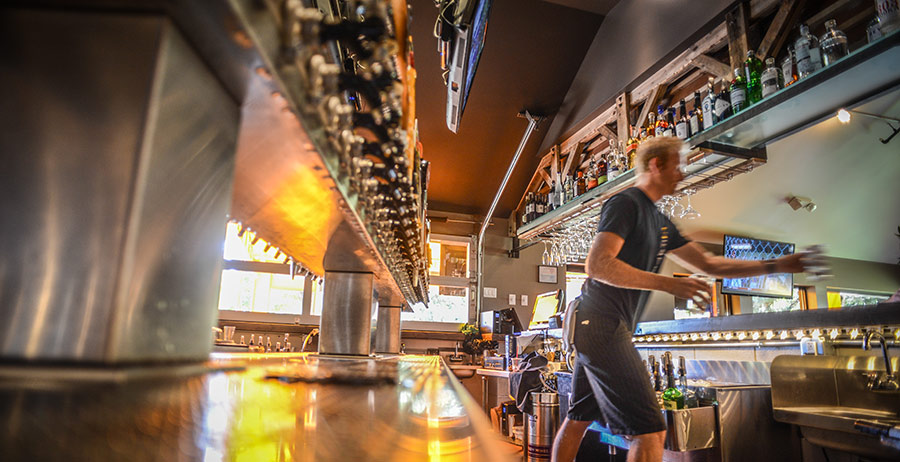By Tim Brady
Popping into a popular craft beer bar in an unfamiliar California city, I found myself overwhelmed by forty draft lines.
“I’m looking for something dank and aromatic, preferably citrusy,” I told the barkeep. “Being from the east coast, I don’t recognize a single IPA on your menu.”
“The triple is good,” the bartender responded in a voice that left me wondering which of us was less confident in the suggestion. I requested a sample pour, but was informed that the bar doesn’t offer taste-sized portions. Assuming that free samples must be prohibited for legal reasons, I asked if I could order a half pour. The barkeep’s response? “No, we just have one pour size.”
I’ve seen scenarios like this frequently on cross-country travel. As more breweries enter the market, and more craft beer bars emerge to showcase obscure and unique offerings, selecting a beer that you’ll like has become ever more challenging. At the same time, the cost of a pint has risen nationwide, which can make it a gamble to order a beer you’ve never tasted before.
Speaking as a consumer, brewery and craft beer bar owner: How do we deal with this?
Samples Cost Money
Now, I’m not advocating for free samples, even in the states where they’re legal. As a small brewery owner, I know that it’s a lot harder for me than it is for the big guys to give away or discount small pours. Storing and serving the beer, cleaning the glassware and taking valuable service time in offering samples—it all comes with a cost, and it’s absolutely fair to pass that cost on to the customer. But by not offering an option to sample the beer, you may be doing a disservice to your guests and your bottom line.
Samples Make Money
In early 2014, our craft beer bar implemented a system to track sample pours. We continued to offer one-ounce samples at no cost, but asked staff to start entering them into our point-of-sale system. Over the course of two years, some interesting data has emerged.
Guest checks that contained at least one sample had a 35 percent higher craft beer sale.
71 percent of guests who request a sample of a beer go on to order a full-sized pour of the same beer. That’s good news! We’re helping them make the correct choice and then allowing them to validate the decision on their own. But here’s another valuable statistic: Guest checks that contained at least one sample had a 35 percent higher craft beer sale than those without a sample pour. Essentially, guests who tried a sample spent more money on either more beer or more expensive beer.

Data to Support Fractional Pours
Seeing the demand in the data for smaller pours, we decided to roll out a fractional pour option—initially offering half pours for a reduced price. The number of unique beers on checks increased, while the average check value remained about the same. However, the number of free one-ounce samples decreased significantly. Therefore, our per-keg profit increased slightly.
We also began offering every draft product in a four-ounce size. That became the standard small pour for all of our beers regardless of the full pour size, which ranges from eight to 20 ounces. It also created a more reasonably priced option for some of our more expensive offerings.
This is when things got really exciting. Our average profit per keg increased 15 percent. In addition, the staff learned quickly that suggesting four-ounce pours instead of free tastes was a way to build check value (and therefore tip value). The number of free samples on checks dropped by one-third, and the number of four-ounce pours more than made up the difference. Eventually we removed the half-pour option altogether. In some cases we even elected to offer rare and specialty kegs only in four-ounce pours, extending their availability to more people and increasing the margin of the keg.
We were making more money for the same work, while also exposing guests to more brands!
These changes resulted in an 18 percent increase in revenue, with only a four percent increase in customers. In addition, the number of brands on checks went from an average of two to four. We were making more money for the same work, while also exposing guests to more brands! As an added benefit, the overall sentiment of the guest experience, conveyed in person and online, improved. Many online reviews mention the ability to create your own four-ounce flight as a reason for making the trek to our out-of-the-way bar and beer garden.
Final Thoughts
As more brands enter the market, it’s more difficult than ever for beer lovers to make educated choices. Bars and breweries need to find creative ways to cover their costs while allowing guests to explore new brands. Careful tracking and pricing of size offerings can make smaller pours, in some cases, even more lucrative than the full-pour options—and will likely increase customer loyalty and improve guest satisfaction. Offering fractional pours is a true win-win for breweries and craft beer bars alike.
 Tim Brady and his wife Amy live and work in Brattleboro, Vermont. Their company, Whetstone Station Restaurant, Brewery & Bier Garten, offers inspired food, local craft beers and great specialty drinks in a picturesque waterfront location. Tim is an active member of the Brewers Association Brewpub Committee.
Tim Brady and his wife Amy live and work in Brattleboro, Vermont. Their company, Whetstone Station Restaurant, Brewery & Bier Garten, offers inspired food, local craft beers and great specialty drinks in a picturesque waterfront location. Tim is an active member of the Brewers Association Brewpub Committee.



 Resource Hub
Resource Hub